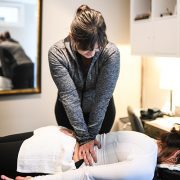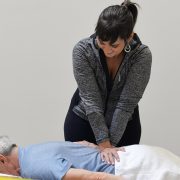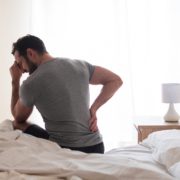Three Ways to Keep your Back from “Going Out”
Four out of five people will experience a debilitating back pain episode at one point during their lives. For many this will be from a pulled back muscle.
Typically, we put more effort into caring for our backs during those times than when we’re feeling good. But it’s critical that we take good care of our backs all the time, not just when we’re in pain.
The real secret to keeping your back healthy is in your daily habits.
Pulled a Back muscle? Here are three ways to take care of your back on a daily basis. So that you can keep it from “going out”:
1. Avoid sitting for prolonged periods.
When we sit for too long, the burden of our weight is placed abnormally on our spine and can cause damage over time. Before long, those small loads add up to real pain. It makes sense when you consider that our bodies were designed to stand, sit, crawl, run, kneel, bend and move through the world in many different ways. It was never designed to sit in one position for prolonged periods, day after day. Sit too long, too often, and it can lead to bulging discs and weak, brittle muscles that are prone to tearing and other damage.
The solution?
Limit your sitting to half-hour periods. Have a few minutes of standing in between, and you’ll reduce the uni-directional forces on your spine. If you sit for a long time at work or at home, stand up and walk around a little bit every thirty minutes. I give this advice to every single client I have who comes to me with back problems. It’s one of the easiest ways for the average person to prevent a debilitating back problem over the long term.
2. The curves in your spine matter
We have natural curves in our spine that help us handle stress and loads. Whether sitting or standing, it’s important to maintain these curves. When standing, our spinal curves occur more naturally and are usually easier to maintain. But when we sit, the protective curves in our spine are harder to maintain and often disappear, and you’re often completely unaware it’s happening.
While strong back and abdominal muscles are an important component to maintaining a healthy back, they do very little when it comes to sitting and maintaining those curves, which is a common misconception in the medical and fitness community.
Fortunately, the solution is simpler than you think. Using a lumbar roll every time you sit goes a long way in helping you maintain the natural curves in your spine – and with minimal effort or thought. The good news is you can craft one quite easily on your own using a small towel roll or pillow. Simply place it between the small of your back and the chair and it will help you to maintain the natural lordosis (or curve) of your lower back. Give it a try. You’ll be amazed at how effective this one simple tip is for helping to control and prevent back pain.
(Did you know we have Lumbar Rolls right here in our Portsmouth office? Email [email protected] if you’re local and want to get one)
3. Extend instead of bend.
Did you know that the average person bends or flexes forward between three and five thousand times per day?
That’s a lot of bending over time and eventually something will give – and it tends to be your lower back. Our spines crave balance, but unfortunately, our modern-day lives are designed to have us bending forward more than we should. Sitting in front of a computer, putting shoes and socks on, driving, house and yard work, even brushing our teeth are all daily activities that involve bending forward in some way.
To combat this, we need to make a concerted effort to extend instead of bend. A really simple exercise you can do every day is to stand and extend your spine. Place your hands on your lower back for support and then arch back as far as you can go. Repeat this 10 times, at least once per day. If you’ve never arched your back like this before, it may feel stiff or even hurt a little at first. But with a gradual increase in frequency, it will feel less stiff and more natural over the course of a few days. If it doesn’t, or becomes troublesome for you, then it’s important to speak with a specialist.
Getting rid of a back problem really isn’t as complicated as you think – and it could be as easy as starting with simple tips like these.
These tips are considered basic “back hygiene” that everyone should consider incorporating into their daily routine. But if you’ve had several back pain episodes year after year, or every few months, these tips may only take you so far and it’s important to enlist the help of an expert.
CLICK HERE to request a FREE Discovery Call with one of my specialists.
Someone from my client success team will call you right away and see if you are a good fit for what we do.
Dr. Carrie Jose, Physical Therapist and Pilates expert, owns CJ Physical Therapy & Pilates in Portsmouth and writes for Seacoast Media Group. To request a free copy of her guide to back pain CLICK HERE or to get in touch, email her at [email protected].










